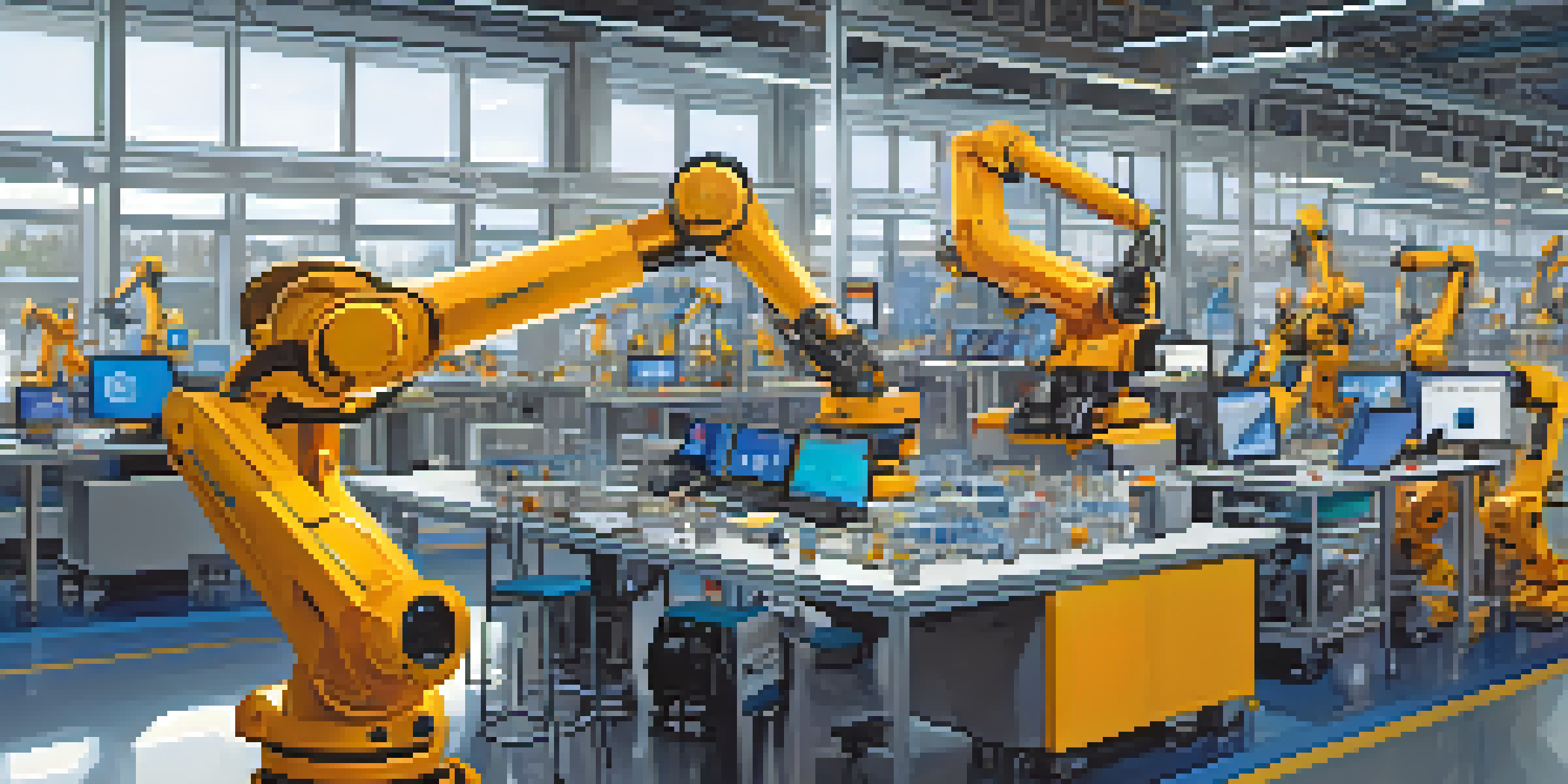Integrating Computation and Networking in Smart Manufacturing

Understanding Smart Manufacturing and Its Importance
Smart manufacturing represents a transformation in how products are created, integrating advanced technologies like IoT, AI, and big data. This approach not only boosts efficiency but also enables real-time decision-making, which is crucial in today's fast-paced market. By embracing these innovations, manufacturers can respond swiftly to changes in consumer demand and operational challenges.
In the age of smart manufacturing, the ability to adapt and innovate swiftly is not just an advantage; it's a necessity for survival.
At its core, smart manufacturing leverages interconnected systems to streamline processes and reduce downtime. For instance, a factory can utilize sensors to monitor machine performance continuously, anticipating maintenance needs before they become critical issues. This proactive strategy helps avoid costly disruptions and enhances overall productivity.
Moreover, smart manufacturing promotes sustainability by optimizing resource use and minimizing waste. By analyzing data from various sources, companies can make informed decisions that lead to more environmentally friendly practices. This dual focus on efficiency and sustainability positions businesses to thrive in an increasingly eco-conscious market.
Key Components of Smart Manufacturing Systems
The backbone of smart manufacturing consists of interconnected devices and systems that communicate seamlessly. These components include sensors, actuators, and robotics, all of which contribute to a cohesive manufacturing environment. By integrating these technologies, manufacturers can create a responsive and flexible production line.

Data analytics plays a critical role in this ecosystem, allowing manufacturers to derive actionable insights from vast amounts of information. For example, by analyzing production data, a company can identify bottlenecks and optimize workflows, leading to significant time and cost savings. This capability transforms raw data into a strategic asset.
Smart Manufacturing Boosts Efficiency
By integrating technologies like IoT and AI, smart manufacturing enhances productivity and enables real-time decision-making.
Additionally, cloud computing enables manufacturers to store and process data remotely, providing scalability and accessibility. With cloud solutions, teams can collaborate on projects in real time, making it easier to implement changes and innovations across the production process. This interconnectedness fosters a culture of continuous improvement.
The Role of IoT in Smart Manufacturing
The Internet of Things (IoT) is a game-changer in the realm of smart manufacturing. By connecting machines and devices to the internet, manufacturers can monitor operations in real time, leading to enhanced visibility across the production floor. This level of insight empowers teams to make informed decisions quickly.
Data is the new oil; it's valuable, but if unrefined, it cannot really be used.
For instance, IoT sensors can track inventory levels and machine performance, alerting staff to any irregularities or maintenance needs. This not only minimizes downtime but also ensures that production runs smoothly without interruptions. In essence, IoT acts as the eyes and ears of the manufacturing process.
Moreover, IoT facilitates predictive maintenance, which anticipates equipment failures based on data trends. By addressing potential issues before they escalate, manufacturers can extend the lifespan of their equipment and reduce repair costs. Ultimately, IoT integration drives efficiency and reliability in manufacturing operations.
Harnessing Big Data for Enhanced Decision-Making
Big data analytics serves as a cornerstone for effective smart manufacturing strategies. By collecting and analyzing large volumes of data from various sources, manufacturers can uncover patterns and trends that inform business decisions. This capability transforms manufacturing from a reactive process to a proactive one.
For example, analyzing customer feedback alongside production data allows manufacturers to align their output with market demands. By understanding consumer preferences, businesses can tailor their products and services, ensuring they meet customer expectations. This customer-centric approach fosters loyalty and drives sales.
Collaboration Drives Innovation
Partnerships between manufacturers, tech providers, and academic institutions foster knowledge sharing and accelerate the development of new solutions.
Additionally, big data can enhance supply chain management by providing insights into supplier performance and market conditions. With this information, manufacturers can make smarter procurement decisions and mitigate risks associated with supply chain disruptions. In today's unpredictable market, such foresight is invaluable.
Cybersecurity Challenges in Smart Manufacturing
As smart manufacturing systems become increasingly interconnected, cybersecurity has emerged as a critical concern. Cyberattacks can disrupt operations, compromise sensitive data, and lead to significant financial losses. Therefore, manufacturers must prioritize robust cybersecurity measures to protect their assets.
Implementing strategies like network segmentation can help mitigate risks by isolating critical systems from potential threats. This way, even if one part of the network is compromised, the impact on the overall operations can be minimized. Regularly updating software and employing strong authentication methods also bolster security.
Moreover, fostering a culture of cybersecurity awareness among employees is essential. Training staff to recognize potential threats and respond appropriately can significantly reduce vulnerability. By building a resilient workforce, manufacturers can strengthen their defenses against cyber threats.
The Importance of Collaboration in Smart Manufacturing
Collaboration is a vital element in the successful integration of computation and networking in smart manufacturing. By fostering partnerships between technology providers, manufacturers, and academic institutions, companies can drive innovation and overcome challenges. This collaborative approach facilitates knowledge sharing and accelerates the development of new solutions.
For example, manufacturers can work with tech firms to develop customized software that addresses specific operational needs. This tailored approach ensures that solutions are not only effective but also aligned with business objectives. Collaboration can lead to the creation of cutting-edge technologies that enhance productivity and efficiency.
Cybersecurity is Crucial in Manufacturing
As manufacturing systems become interconnected, robust cybersecurity measures are essential to protect against potential cyber threats.
Additionally, engaging with research institutions can provide manufacturers access to the latest advancements in technology and best practices. This continuous learning environment empowers companies to stay ahead of industry trends and maintain a competitive edge. Ultimately, collaboration fosters a thriving ecosystem for smart manufacturing.
Looking Ahead: The Future of Smart Manufacturing
The future of smart manufacturing is poised for remarkable advancements, driven by ongoing innovations in technology. As artificial intelligence and machine learning continue to evolve, manufacturers will gain even deeper insights into their operations and customer needs. This will allow for more personalized and efficient production processes.
Moreover, the integration of advanced robotics and automation will further streamline manufacturing operations. From collaborative robots (cobots) working alongside humans to fully automated production lines, these technologies promise to enhance productivity and reduce human error. The synergy of human and machine will create a more resilient manufacturing ecosystem.

As manufacturers embrace these changes, they will also need to remain agile and adaptable. The ability to pivot quickly in response to market demands will be crucial for success. By fostering a culture of innovation and continuous improvement, companies can thrive in the dynamic landscape of smart manufacturing.